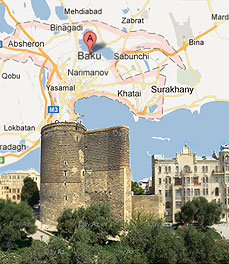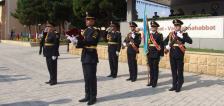News
HomepageMARCH 31 - DAY OF AZERBAIJANI GENOCIDE
31.03.2015
Since 1998, March 31 is commemorated in Azerbaijan at the state level as the Day of Genocide of Azerbaijanis. Massacre of Azerbaijanis by Armenian nationalists, exposure of repression, expulsion and exile from their native lands in the ХХ century are one of the most tragic and terrible pages of our history.
In 1917-1918, Armenians, taking advantage of events in Russia, tried to reach their hateful intentions under the guise of Bolshevism. Led by Stepan Shaumyan acting from a position of "class struggle" and "class character" against the national peace and unity, the Baku Bolsheviks chose the path of "Baku Council transformations into the main center and stronghold of the civil war in Azerbaijan". They, together with the Dashnaks at the end of March (30-31th) of 1918 organized the national massacre called fight against "anti-soviet insurgency", "counter-revolution". Approximately 7000 Armenian soldiers were brought to Baku from different fronts. Moreover, 70% of the army of 10-12 thousand people, created under the name "Red Guard", consisted of Armenians. According to the preliminary agreement, Bolshevik-Armenian coalition along the front moved to the attack. In the evening of March 30 at Baku the first sounds of the fire opened were heard. Armed head to toe Armenian soldiers attacking the homes of Muslims massacred them, did not spare children and old people.
It was a national genocide against Muslims, especially Azerbaijanis, the treacherous plot against the national independence of Azerbaijan. During the genocide more than 12000 (according to some documents - 15000) innocent Azerbaijanis were killed. In commitment of this genocide Dashnaks militias especially distinguished, as well as the "Red Guard" headed by A. Mikoyan. Nariman Narimanov spoke about the massacre committed by Armenians: "The Dashnaks did not spare even muslim Bolsheviks. They committed all possible crimes against Muslims. Not only men but also pregnant women could not be escape".
It should be noted that the attempt to commit a massacre in Baku was undertaken even in January 1918. The arrest of the commander of the Muslim corps, General Talyshinskiy caused serious anger of Turkic Muslim population of the city. Taking advantage of this, Armenians attempted to commit an armed conflict. However, as a result of efforts of N.Narimanov and others, the plan of massacres in January did not take place. They were able to make hateful intentions in March. S.Shaumyan at the meeting of the Baku Council said that this organization should be the main fortification of the civil war in the Caucasus. A pretext for the collision was the arrival of 48 militarists, organizing the delivery of the body of the son of Haji Zeynalabdin Taghiyev, Magomed, on the board of ship "Evelina" from Lankaran to Baku. Armenians spread the rumor that these officers have received an order to crush Malakan village in Mugan. Referring to this Shaumyan ordered to disarm of the officers on the ship. And objected to this local population, going to the streets protested against disarmament of the officers. Thus the genocide against the civilian population started. In the report of the Commission of Inquiry, organized in the period of Azerbaijan Democratic Republic, the number of deaths during these events is indicated as more than 20 thousand people.
During the March genocide in Baku only more than 12000 people were killed. These atrocities of the Bolshevik-Dashnak corps were not only in Baku. They continued genocide in Guba, Shamakhi, Kurdamir, Salyan and Lankaran. Corps of Lalayans village committed the massacre of the population of Shamakhi. With the help of the local Armenian and Russian-Malakan villages only in March by the Armenian troops 58 villages were defeated. Approximately 8000 people were killed, of which 1653 - women and 965 - children. In Shamakhi, whose population in 1918 was 15000 people, in 1921 it was approximately 1700 people.
There are a lot of archival material proving massacres committed by Armenians in March and April 1918 in Shamakhi and neighboring villages. Data collected in the analytical materials, consisting of 925 pages, 7 volumes about the genocide committed by Armenians in Shamakhi and neighboring villages, once again show the crimes and violence committed by the Armenians. Note that according to the document, prepared by mentioned Inquiry Commission, the Baku Council sent to Shamakhi 15 trucks, and in mid-March 60 trucks full of weapons and 2000 Armenian soldiers.
In Guba events took place in the same direction. Commander of the corps of Dashnaks Hamazasp sent to Guba in April, said: "I'm the hero and defender of the Armenian people ... I was ordered to destroy all Muslims in the territory from the Caspian Sea to Shakhdag". Dashnak troops under his command burned in Guba 122 villages. And local residents were killed as martyrs. Poking people's eyes out, Armenians made "charms" of them. During the genocide by the Armenian nationalists about 30 thousand people were killed.
Armenians tried to occupy the whole Azerbaijan. At this time, uniting with the Armenians living in Karabakh, they prepared to attack Ganja. However, in May 1918 the establishment of the Azerbaijan Democratic Republic, support of Azerbaijan by Ottoman Empire destroyed all the plans of the invaders.
In reality, the March events were the national massacre committed by the Bolsheviks with the Dashnaks. In his letter to the Council of People's Commissars of the RSFSR dated on April 13, 1918, the chief organizer of the massacre S. Shaumyan admitted it: "We used the attempted armed attack on our cavalry unit as an excuse and went on the attack all along the front ... The number of our armed forces was about six thousand people. The "ARF" had national corps of three or four thousand people who were at our disposal. Participation of national corps gave the character of national massacre to the civil war, but it was impossible to prevent. We deliberately made it."
In March-April 1918, the Armenian nationalists killed in Baku, Shamakhi, Guba, Lankaran and other regions, 50000 Azerbaijanis, tens of thousands of people were expelled from their homelands. These events were written in the history of the Azerbaijani people in black letters.



